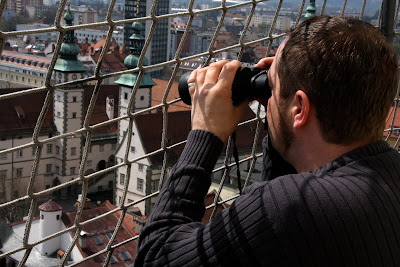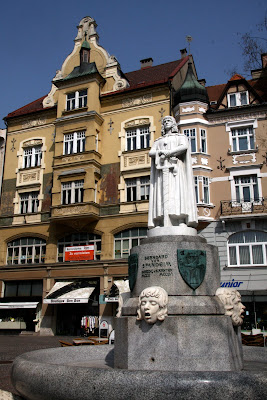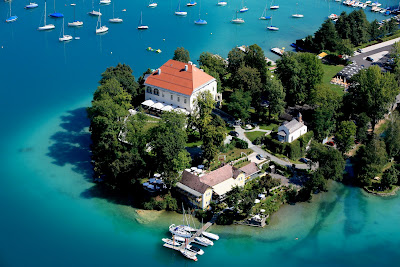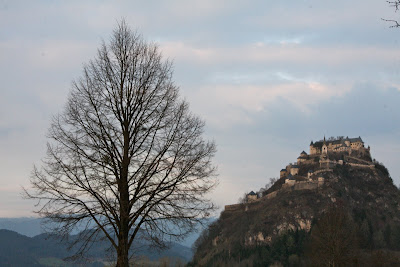
It takes 44 seconds to enter the history of Klagenfurt. So many in fact has used to win last Guenter Wand turmeric Lauf: a mad rush to the top of the tallest tower in the Carinthian capital, which calls on each June to climb 225 steps to earn a very thin view over the city and the inevitable kiss of glory . Formerly used as a lookout enemies and to summon assistance in case of fire, even today the tower of the parish is inhabited by a supervisor who has the power to awaken the dead playing his horn to the south, as already its predecessor was able to terrorize the locals when they joke of his office.

The competition, which is rooted in superstitious rites of New Year's Eve and repeated precisely at the end of year, is undoubtedly one of the most beloved local traditions, as the renewed cult of the hero capable of crossing human limitations. Just like a time he touched the founder of Klagenfurt, a young man on whom no one would bet a penny of cheese, yet the only one able to bend under his terrible dragon Lindwurm the club, now imprisoned in a block of stone from 124 tons, which was mysteriously carved in 1590 by Ulrich Vogelsang. Using the calvarium as a model of a woolly rhinoceros glacial age (eg, a skull without the mandible, more returns 600 years ago on nearby Mount Zollfeld), the winged lizard Vogelsang may in fact represent the first attempt at "scientific" reconstruction of a prehistoric animal hero of countless legends. Above all, the one who wanted him puffing and hungry in the marshy waters of the river Drava and Lake Woerther, the site where is precisely the modern city Dragon.

Its inhabitants, however, should not have removed all of the ancestral fear of the monster, because there continue to be grown supermen steel: they are the so-called "Iron Men", the protagonists of the most famous and grueling triathlon Europe in July that gathers athletes from all over can swim for nearly four miles, bike for speeding in another 180, then rushing to run toward a target 42 kilometers away yet. Along with "days of fitness", scheduled in late August, is but one of many events held each month in celebration of this town always and constantly in form, as is well demonstrated by the many nudists who flock to the oasis of natural surroundings, including the Keutschachersee and Spintikteiche, but also the many gourmet markets, or Christmas crafts, performing arts and music festival.

call the "Rose of Woerthersee" because of its mild climate and hedonistic in our beloved lake shore dell'artistocrazia Habsburg, Klagenfurt preserves something truly magical. A kind of cosmic harmony that blends perfectly balanced nature and culture, the great dream of Germanic philosophy. It is no coincidence that the defendants here are some of the greatest geniuses of all time, from the writer Robert Musil and the poetess Ingeborg Bachmann (which is also dedicated to a meticulous museum in the city center, the native of the place) to get to the pen of Arthur Schnitzler, who on the shores of Lake tried to redeem the torment of Finis Austriae through "Miss Else", via on until all'inquieto composer Gustav Mahler, which still keeps the small studio where was used to retire to write his symphonies dream. It is located a few miles west of the city, hidden in an idyllic woodland that slopes gently toward the Woerthersee, and represents a stage of inspiration to fully appreciate the musical journey in 2010 celebrates the 150th anniversary of his birth.

Unlike Vienna, where strong and intense is the nostalgia of the golden imperial order, Klagenfurt seems to live in an eternal present, whose lively Renaissance and Baroque buildings do not show a crack, a patch, the streets are always crowded of young people, especially in the evening when it begins the rendezvous between Checkpoint Charlie and The Passage, between the Renaissance and the Carpe Noctem, jumble of small rooms in the historic center, the peculiar characters of the curious "Carinthian movida" a stream of devotees jazz, as well as the pop or rock, which exploits the sprawling network of courtyards with arches through which you can project quickly from the laboratory of the sandwich creative-The Fresh Deli Bar Schleppe of the brewery, letting yourself be charmed by the play of light reflections on their walls spotlessly clean.

The same Lendkanal, built more than 450 years ago, still works perfectly and is the most romantic way to travel from the heart of the city to the beach Woerthersee Here stretches the picturesque peninsula of Maria Loretto, where at the end of the short boat trip is a must to enjoy a candlelit dinner in the homonymous restaurant (unless you want to embark again to reach the most secluded villas of the lake).

Or think of the vulcanic creative modern art museum (www.mmkk.at), formerly the College of the Protestant nobility in 1586 and later residence of the Carinthian burgraves, able to devote more than a thousand square feet to taste pure avant-garde installations in the old air Baroque chapel frescoed by the painter Josef Fromiller, creative workshops every weekend for families, free visits to artists' personal area of \u200b\u200bthe Alpine-Adriatic on Thursday evenings, and reading in three languages \u200b\u200b(German, Italian and Slovene) and alternative cinema in a courtyard by striking resonant effects. This incredible vitality
town is perhaps related to the deep ties that the inhabitants Klagenfurt able to maintain with the land, always considered a part of and irreducible to centralize the work of the Habsburg Empire. When the Carinthian capital was in fact completely destroyed by fire in 1514, Maximilian I said he did not have money to rebuild their homes and unique case in imperial history, was forced to give up the scepter of the regional assembly, ready to go to revive its prosperity under the stylish urban vision of the Italian architect Domenico dell'Allio.

Building on its position as a crossroads, being at the confluence of trade routes between and cultural forces in Latin, Slavic and Germanic, Klagenfurt has done so in order to mature a very independent spirit, but never aristocratic disdain. There is a clear victory in the Hall of Coat of arms within the Landhaus (Regional Palace): there are 665 well and represent each administrative authorities in Carinthia, covering the entire walls that look on the symbolic seat of the oath. A block of stone hewn unpretentious, on which the Duke of Carinthia was called to swear in front of all the farmers, that would commit to protecting the rights of the people. Pace absolutist sovereigns like Maria Theresa, who still is there in the middle of the new square, with eyes annoyed over the Rathaus, which is the town hall.

The popular impression of the city is so strong that every corner lurks fearing stories and warnings against the arrogance of the elite: the Benedictine market, where the scent of Carinthia ravioli mixes with the bacon and of bread, every Saturday morning the stalls are stored under the iconic statue of the fisherman, a woman who doubt the correctness of its prices apparently had shouted: "What is that stone if I weighed evil." Said than done. From 1606 we are no longer moved from there. Worse revelers went to the city, regardless of Easter, continued to squander their wealth in wine and dancing at various times warned by a little man who went around with a barrel under his arm, do not trouble themselves about it until they decided to remove the cap, in an overwhelming flood of water that came to give life to lake Woerther. That is why today hurry to passers-by throwing some coin with reverence, not just stumble into a fountain at the entrance of the center.

As the sullen mask that only the wisest notice on the building next to the old town hall, seems to emerge from the central wall to remind the judges before giving a sentence beyond the social status of a person, you should always investigate until the ultimate truth, not to get caught up quickly or rancor: his face reminiscent of that of a baker who was accused of having done away with some money given to it, thus being sent to the gallows, when in fact were later found in the same spot where the dead were thought to be innocent. This also explains why such a weird name for a city, "the ford of mourning", the marsh (theft), on which rose the cries of despair (Klagenfurt) of citizens threatened by the dragon, but also the perpetrators of injustice assailed by remorse.

Ben are therefore the activity physics and the joy of living in Klagenfurt, but always without stress. Never exceed. The great virtue of its citizens lies precisely in this strong sense of the measure, which has the wonderful ability to adapt to the real thing every human being. Not surprisingly then, as the old town was also the first totally pedestrian in Austria, since 1961, or any cycling race here with confidence both inside and outside the urban area, by bicycle or horse, the best way to explore the circuit of Renaissance castles in the immediate vicinity. A city that seems to really have the soul of a delicate flower and timeless, which only the words of a poet it justice. And, perhaps, the innocent smile of a girl who whispered: "I will take you to the last rose of the garden, the white rose that blooms in the early mist. The greedy bees have visited it until yesterday, but it's still so sweet shakes. It 's a picture of yourself for thirty years, a bit' absent-minded, as you will then .... "

MAHLER CONTEMPORARY

"Tradition is the gift of fire, not the worship of ashes." Building on this maxim of Mahler, which calls to light the spark of inspiration, from 9 July to 1 August festival "Mahler Contemporary" will transform the area into a huge musical stage Klagenfurt. Over 70 artists from 10 different countries will be committed to undertake to celebrate the 150th anniversary of the birth of the great composer (1860-1911), who Maiernigg - near Klagenfurt - he wrote the Fifth, Sixth and Seventh Symphony in the 1900 and 1907. Location of reference will be the former Cistercian abbey Viktring, a baroque jewel in the heart of the countryside of Carinthia, where the main events will be proposed activities, including six evening concerts of classical and avant-garde jazz, with performances by two videoperformances dance, and exhibitions "Mysterious Traveller" and "Images of a symphony."

The cabin Maiernigg composition will again be filled with music, as well as the Conservatory of Klagenfurt, where since May 10 the association Woerthersee Classics will be involved in many tributes, edited by Professor Alexei Kornienko (the whole program is available at www.woertherseeclassics.com). The exhibition intends to go beyond Austria's borders, since the international art platform "Mahler Quartet will also be active in Italy, Slovenia and southern Germany, in anticipation of the initiatives that will characterize the second jubilee year. In 2011 we will commemorate the centenary of the death of Mahler, an artist who was able to transform so much sorrow and pain of his life in an ever-changing face of music, anticipating the most daring experiments of the twentieth century.
THE LEGACY 'OF KEVENHUELLER

More than castles, palaces look like today. There are at least 23, a different, some perched on the hills, others lavishly decorated in the gardens of the country. None of the old houses of Klagenfurt, however, can compete with the fortress of Hochosterwitz (www.burg-hochosterwitz.at), perhaps the best example of defensive structure in Carinthia equipped itself to ward off the invading Turks. Mentioned for the first time in 860, this unique castle - barricaded completely isolated on a hill about twenty miles from the city - allows you to relive the epic of chivalry between halberds, guns and collections of armor forged from the same manufacturer that still , supplies the Papal Swiss Guard. It can be reached after crossing a total of 14 portals that take place continuously from the base to the top of the hill, reached by a scenic cable car.

The last heir of the noble family Kevenhueller, a few months ago happened to his father in the conduct of the castle, has, inter alia, decided to start a series of works by reorganization of interior spaces, through which you can assist with re-enactments in medieval costume, traditional dinners, shows and concerts under the stars chivalry as early as this summer.
OASIS WELLNESS

so pure, it can be drunk directly from the lake. The water of Woerthersee, but in general the whole lake area in Carinthia, is without doubt one of the most precious treasures of this region, that the Romans knew how to appreciate, creating a major thermal plant in the nearby town of Villach. If the intense blue of the more large lido in Europe is able to capture most of the boats, it is true that many local people prefer the intimacy of most lakes in the vicinity, including the Rauschelesee the Hafnersee the Keutschachersee Spintikteiche and picturesque, surrounded by a dense forest Alpine, but the waters are warm and balmy. Needed were two or three bathrooms to completely regenerate its skin, giving it a softness and elasticity unaware of the time. These oases populated by loons, grebes and deer, are easily reached on foot, by bicycle or on horseback, starting from the charming park of the abbey of Viktring. Although it is not far from Klagenfurt, provide a rich offering private rooms (zimmer) where to stay overnight and enjoy the atmosphere of the countryside of Carinthia: natural juices of apple, a variety of quality sausage flavored with paprika and pistachio, wild mushrooms breaded and jams are just some of the delicacies produced directly on site.
THE LITTLE TIBET

Just like the mysterious Shangri-La, the Lingkor of Huettenberg (www.huettenberg.at) is one of the least known and most beautiful jewels of Carinthia. Hidden in the valleys of the Norian, less than an hour's drive from Klagenfurt, this surprising Tibetan complex was created by the explorer Heinrich Harrer, who took to the movies the face of Brad Pitt in the movie "Seven Years in Tibet", inspired by his friendship with the Dalai Lama. Bridges of chains hanging in the air, colorful scarves tied to the plants and votive Buddhist stupas have been played around the museum dedicated to the great explorer, inspired by the original Himalayan. Besides being a place of prayer and meditation, Huettenberg is also a point of reference for the peace movement in Austria, as well as an exclusive showcase on the most remote tribal cultures of the world. Harrer here has in fact collected the remains of his incredible journey to the border, which in addition to Tibet, touched the remote island of Papua, the Amazon, the Guianas and the Andamans, not to mention its many shipments in Black. Among the most loyal visitors to the site should be counted no less than the Dalai Lama for years been connected to his friend, with whom the youth living in exile in India Potala in Lhasa, before his death in 1996.
RESTAURANTS

ZUM AUGUSTIN
(www.gut-essen-trinken.at)
Locanda wooden style of Carinthia, is located in front of the parish of Klagenfurt, Pfarrplatz, and is a historic meeting of the city, is to drink a beer for lunch or dinner. Among the house specialties, soups, goulash, pork steaks in mushroom sauce, spaetzle juniper butter. In summer you can sit even in the airy courtyard. A meal is about € 13.
PUMP
Hidden in the narrow alley that gives the market place Benedictine, this arrangement with the brewery Hofbrauhaus of Monaco is the highlight of the Germanic tradition: soup and chive omelette, breaded pork chop, grilled rich. Prices around 15 €.
HOHENWIRT
(www.hohenwirt.at)
Who wants to spend an intimate evening can easily reach this elegant restaurant in the hills, following the road that leads to the Pyramidenkogel. It looks out onto a terrace overlooking the lake region, providing welcome as a vegetarian buffet. Do not miss their spinach ravioli stuffed with cheese, salmon trout, meatballs with garlic and chilli, but most of all the delicious cakes of flour and eggs to dip into the cranberries. Prices around 20 €.
HOTELS
SANDWIRTH
(www.sandwirth.at)
E 'the oldest hotel in Klagenfurt, active since the sixteenth century and counts among its guests degrees historical figures, including Churchill and Hitler. It consists of 100 rooms, 2 suites and 6 deluxe, in an original mix of modern and classic style, providing a small sauna and spa area. The cozy lobby of 180 square meters, derived from the ancient mail, introducing the trendiest cafes in Klagenfurt, where every night you can find the cream of society. Prices double from 100 €.
PRETTNER
(www.romantik-zimmer.info)
Small private guesthouse on the main street of Klagenfurt, in Alter Platz 16, you stay in one of folk arcaded courtyards of medieval origin. The rooms are furnished to the Carinthian, with wood trim and linen while the breakfast in the morning is nothing short of gourmet. Prices from 42 € per person.
Pichlerhof
(www.pichlerhof.co.at)
If you are looking for peace and relaxation, this ancient farmhouse on the hill overlooking the oasis Rauschelesee where repair. It is located in the village of Hoeflein along the direct road to Klagenfurt-Velden. Provides both private rooms and apartments, with a typical breakfast of orange juice, jams, meats, fresh eggs, locally produced cheeses and pates. Prices around 25 €.
0 comments:
Post a Comment